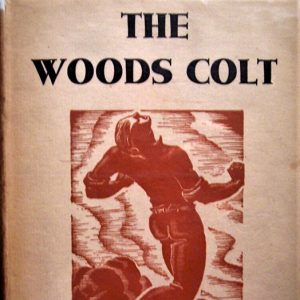calsfoundation@cals.org
The Woods Colt
Thames Williamson’s The Woods Colt, published by Harcourt, Brace and Company in 1933, was the first Ozarks-based novel to be a significant popular and critical success. The novel was a selection in the Book of the Month Club for October 1933 and was praised by several critics, including an anonymous reviewer who, in the October 1933 issue of Time, argued that it was worthy of a Pulitzer Prize.
Set in the early 1930s, The Woods Colt (a regional term for an illegitimate child) tells the story of Clint Morgan, a young man who was brought up fatherless and shunned by many members of his community. He is now a jealous and rowdy hill man courting the voluptuous and flirtatious Tillie Starbuck, and he is charged with attempted robbery after starting a fight with a rival suitor in the local post office. Believing that he will be sent to prison, Clint escapes custody and, aided by a teenage female cousin, repeatedly outwits his pursuers until finally cornered by a posse. While on the lam, Clint murders a U.S. marshal, bushwhacks a stranger in the backwoods, and makes love to his cousin.
Although Williamson does not indulge in stereotypes to the extreme degree that many authors did, he does make the region appear exotic and entertaining to outside readers. Moonshine is alluded to over 100 times; scantily clad women and bearded, gun-toting mountain men roam the hills; folklore pervades most conversations; and the entire novel is written in dialect. Williamson enhances the perceived authenticity of his depictions by dedicating the novel to the eminent folklorist Vance Randolph “because he is the acknowledged authority on Ozark dialect, because we traveled them thar hills together, and because he twice went over this story in the painstaking effort to make it regionally perfect.”
Reviews of The Woods Colt appeared in the Boston Transcript, Christian Century, Nation, New Republic, New York Times, North American Review, Saturday Review of Literature, Yale Review, and other newspapers and journals. Many reviewers praised the authenticity of Williamson’s depiction of Ozarks folkways and dialect, and Thomas C. Langdon stated in The Pittsburg Press that The Woods Colt “was a handbook on Ozark folk customs, dialect and superstitions.” Although some critics were concerned that The Woods Colt was hampered by its regionalism, most believed it to be a noteworthy literary success. Perhaps the most resounding praise came from the Yale Review, which declared that the novel “belongs on the shelf with Faulkner and Caldwell.”
The fact that Williamson was an established author may have positively influenced the critical reception of The Woods Colt. Thames Ross Williamson was born in Genesee, Idaho, on February 7, 1894; graduated from the University of Iowa in 1917; and earned a master’s degree from Harvard University in 1918. Before writing The Woods Colt, he had published more than a dozen books with major publishers, including his widely praised Hunky in 1929, which was also a Book of the Month selection. Although Williamson published approximately two dozen books following the success of The Woods Colt, he never returned to the Ozarks in his writings. In the spring of 2023, the University of Arkansas Press reissued The Woods Colt.
For additional information:
Barrick, Mac E. “Folklore in The Woods Colt: Williamson’s Debt to Randolph.” Mid-America Folklore 13 (Winter/Spring 1985): 19–20.
Brickell, Herschel. “Among the Mountaineers of the Ozark Hills.” Books, October 8, 1933, p. 4.
———. “The Literary Landscape.” North American Review (December 1933): 570.
Blevins, Brooks. Arkansas/Arkansaw: How Bear Hunters, Hillbillies, and Good Ol’ Boys Defined a State. Fayetteville: University of Arkansas Press, 2009.
“Books: Ozarks.” Time, October 9, 1933, p. 67.
Howerton, Phillip Douglas. The Literature of the Ozarks: An Anthology. Fayetteville: University of Arkansas Press, 2019.
Kunitz, Stanley J., and Howard Haycraft, “Thames Williamson.” In Twentieth Century Authors, New York: H. W. Wilson, 1942.
Langdon, Thomas C. “Pennsylvania ‘Dutch’ Characters in Novel.” Pittsburg Press, September 23, 1934, p. 32.
“The Library of the Quarter.” Yale Review 23 (1933): IX.
Marsh, Fred T. “A Dramatic Tale of the Ozark Hills.” New York Times, October 8, 1933, p. BR7.
Williamson, Thames. The Woods Colt. New York: Harcourt, Brace, 1933.
Phillip Howerton
Missouri State University
 Early Twentieth Century, 1901 through 1940
Early Twentieth Century, 1901 through 1940 Literature and Authors
Literature and Authors Woods Colt, The
Woods Colt, The 



Comments
No comments on this entry yet.